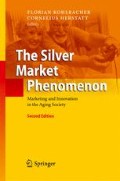Abstract
Demographic change will pose distinct challenges for companies. The ratio of people over 65 years of age will rise in all triad countries. At the same time, the number of younger people, and thus recruits in all education levels, will drastically decline in Japan and Germany. In the USA, a shortage of highly skilled and educated workers is expected. The employment rate of aged people will therefore rise. Companies can react on many different levels. On the one hand, they can make it a business opportunity by developing and selling products and services that support older people. On the other hand, companies will have to cope with fewer younger workers. We discuss several ways to do this (1) to prevent loss of skills from retirement, (2) to accommodate older workers, and (3) to survive with fewer workers. These could lead to Business-to-Business (B2B) products and services that can help companies to solve the issues involved. We look at these possibilities in turn, and find that they each lead to ideas that have one or more of the following properties (1) they are actually Business-to-Consumer (B2C) products, (2) they are management or organizational solutions or services, and/or (3) their benefits are not specific to older workers but benefit all employees. Thus, we are led to the conclusion that the technical products best suited for the B2 Industry silver market will not be “silver-specific” products, but products “designed for all” with an emphasis on usability and problem solving.
Access this chapter
Tax calculation will be finalised at checkout
Purchases are for personal use only
References
Commission of the European Communities, Confronting demographic change: a new solidarity between the generations, Green Paper COM(2005) 94 (CEC, Brussels, 2005) http://ec.europa.eu/employment_social/news/2005/mar/comm2005–94_en.pdf. Accessed 16 Jun 2008
United Nations Population Division, Department of Economic and Social Affairs, Expert Group meeting on social and economic implications of changing population age structure, Mexico City, 31 Aug–2 Sept 2005, (UN Population Division, New York, 2005). http://www.un.org/esa/population/meetings/EGMPopAge/EGMPopAge.htm. Accessed 25 Feb 2010
Commission of the European Communities, Demography Report 2008: Meeting Social Needs in an Ageing Society: Full Report plus Annexes (Brussels 2008) http://ec.europa.eu/social/main.jsp?catId=611&langId=en. Accessed 25 Feb 2010
F. Kohlbacher, Knowledge retention and HRM: insights from the “year 2007 problem” in Japan, Paper presented at the Association of Japanese Business Studies (AJBS) conference, Indianapolis, June 2007
Japanese Ministry of Education, Basic School Survey (MEXT, Tokyo, 2007). http://www.mext.go.jp/b_menu/toukei/001/003/csv/tk1102.csv. Accessed 16 Jun 2008
Federal Statistical Office, Germany’s population by 2050. Results of the 11th coordinated population projection (Statistisches Bundesamt, Wiesbaden, 2006). http://www.destatis.de/jetspeed/portal/cms/Sites/destatis/Internet/EN/Content/Publikationen/SpecializedPublications/Population/GermanyPopulation2050. Accessed 25 Feb 2010
J. Fuchs, D. Söhnlein, Vorausschätzung der Erwerbsbevölkerung bis 2050, IAB project no. 16/2005, (Institut für Arbeitsmarkt- und Berufsforschung, Nürnberg, 2005). http://doku.iab.de/forschungsbericht/2005/fb1605.pdf. Accessed 25 Feb 2010
H. Wan, M. Sengupta, V.A. Velkoff, K.A. DeBarros, US Census Bureau Current Population Report, 65+ in the United States: 2005 (US Government Printing Office, Washington, 2006), pp 23–209. http://www.census.gov/prod/2006pubs/p23-209.pdf. Accessed 25 Feb 2010
Japanese Statistics Bureau, Annual report on the labour force survey (Ministry of Internal affairs and Communications, Tokyo, 2005)
P.T. Beatty, M. Visser (eds.), Thriving on an Aging Workforce: Strategies for Organizational and Systemic Change (Krieger, Melbourne, FL, 2005)
D.W. DeLong, Lost knowledge: confronting the threat of an aging workforce (Oxford University Press, Oxford, 2004)
A. Kuebler, P. Mertens, S. Russell, R. Tevis, Enterprises face the aging demographic – some options to overcome demographic challenges in a multinational company. Int. J. Hum. Resour. Dev. Manag. 9, 275–293 (2009)
M. Leibold, S.C. Voelpel, Managing the Aging Workforce: Challenges and Solutions (Wiley, New York, 2007)
Tennessee Valley Authority, Knowledge retention: preventing knowledge from walking out the door (TVA, Knoxville, 2006). http://www.tva.gov/knowledgeretention/pdf/overview.pdf. Accessed 25 Feb 2010
JARA (Japan Robot Association), 2007 Mass-retirement (I) and (II), ROBOT 2007/03 p. 1 ff, 2007/05 p. 1 ff
M. Martin, M. Kliegel, Psychologische Grundlagen der Gerontologie (Kohlhammer, Stuttgart, 2005)
W.A. Rogers, in Attention and Aging, ed. by D.C. Park, N. Schwarz Cognitive Aging: A Primer (Hove Psychology, Hove, 2000), pp. 57–73
F.I.M. Craik, Age-related changes in human memory, in Cognitive aging: a primer ed. by D. Park, N. Schwarz, (Hove Psychology, Hove, 2000), pp. 75–92
P.B. Baltes, U. Lindenberger, U.M. Staudinger, Die zwei Gesichter der Intelligenz im Alter. Spektrum der Wissenschaft 10, 52–61 (1995)
A. Dickinson, R. Eisma, P. Gregor, Challenging interfaces/redesigning users. Proceedings of the 2003 conference on universal usability, Vancouver, 10–11 Nov 2003 (ACM, New York, 2003), pp. 61–68
C. Reynolds, S.J. Czaja, J. Sharit, Age and perceptions of usability on telephone menu systems, in Proceedings of the Human Factors and Ergonomics Society 46th annual meeting, Baltimore, 30 Sept–4 Oct 2002 (HFES, Santa Monica, 2002), pp. 175–179
F. Schieber, in Human Factors and Aging: Identifying and Compensating for Age-Related Deficits in Sensory and Cognitive Function, ed. by K.W. Schaie, N. Charness. Impact of Technology on Successful Aging (Springer, New York, 2003), pp. 5–99
Author information
Authors and Affiliations
Editor information
Editors and Affiliations
Rights and permissions
Copyright information
© 2011 Springer-Verlag Berlin Heidelberg
About this chapter
Cite this chapter
Mertens, P., Russell, S., Steinke, I. (2011). Silver Markets and Business Customers: Opportunities for Industrial Markets?. In: Kohlbacher, F., Herstatt, C. (eds) The Silver Market Phenomenon. Springer, Berlin, Heidelberg. https://doi.org/10.1007/978-3-642-14338-0_26
Download citation
DOI: https://doi.org/10.1007/978-3-642-14338-0_26
Published:
Publisher Name: Springer, Berlin, Heidelberg
Print ISBN: 978-3-642-14337-3
Online ISBN: 978-3-642-14338-0
eBook Packages: Business and EconomicsBusiness and Management (R0)

